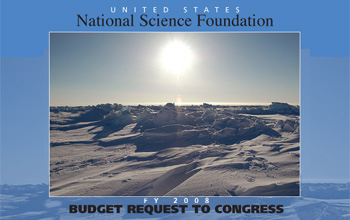|
Web Extra Friday, February 9, 2007
Terrain flat for '08 budget
 |
| President Bush announced the fiscal year 2008 budget request to Congress Monday. NSF's budget fared better than most, calling for a 6.8 percent increase to $6.4 billion. Image is courtesy of NSF. |
On Feb. 5, President Bush rolled out his fiscal year 2008 budget request for the federal government. The request arrives at a time of uncertainty for federal agencies, which are currently operating on a continuing resolution and thus flat budgets rolled over from 2006 levels (see Geotimes online, Web Extra, Jan. 23, 2007), and amid billions more requested for the Iraq war, according to a Feb. 5 Associated Press story.
Regardless of the president's request, however, funding the agencies and programs is ultimately up to Congress. Here's a look at where and how the budget for geoscience programs will shift under the new request, and what some of the agencies' leaders have to say about those changes.
U.S. Geological Survey
NASA
National Science Foundation
Office of Science and Technology Policy
Department of Energy
The president's fiscal year 2008 budget calls for $975 million for U.S. Geological Survey (USGS). This number includes $16.3 million for program increases, $24 million in fixed costs and $10 million in cuts. "We did average to slightly below average relative to other departments," said Mark Myers, USGS director, at a budget press conference Feb. 5. Priorities for the 2008 budget included maintaining key infrastructure components, such as streamgages, and adding new programs that relate to active and immediately relevant science, such as monitoring land use changes.
Myers says the agency needs to make more apparent the relevance and applied nature of USGS work, through programs such as the Healthy Lands Initiative, and perhaps doing USGS work in the private sector. "The survey is doing better than it has, but we haven't been able to tell our story effectively — we need to in the future," Myers says. Some of the budget's numbers and highlights are:
• The USGS will receive $5 million from the Department of the Interior's Healthy Lands Initiative to monitor changes in habitats and landscapes, due to urbanization, and to build a geospatial framework to share information.
• USGS would receive $3 million of the total $80 million designated for ocean science and research to support progress toward fulfilling the goals of the Ocean Action Plan, announced in 2004. Half would go to the Coastal and Marine Geology program for work on coastal ecosystem responses to extreme events, such as hurricanes and landslides. The other half would go to the Hydrologic Networks and Analysis program for water-quality and ecosystem monitoring.
• As a means to maintain basic data collection infrastructure, streamflow monitoring would see a $1.7 million increase over the 2007 budget request.
• Landsat 5 and 7, satellites that monitor changes on Earth, would still be funded in 2008, although their funding would decrease to provide money to launch the priority Landsat 8, which would receive $24 million.
• The Minerals Resources Program was cut by $22 million in the 2007 request (see Geotimes, April 2006), cuts that would be carried over into the 2008 budget. The House recently passed a continuing resolution to restore this funding, although a decision has not yet been made by the Senate.
NASA
NASA's fiscal year 2008 budget request calls for
a 3.1 percent increase, for a total of $17.3 billion. NASA does not plan
any strategic changes in its 2008 budget, and will continue to work toward
transitioning from the space shuttle to the crew exploration vehicle (CEV),
according to NASA's 2008 budget request summary (see Geotimes,
July 2006). Also planned for fiscal year 2008 are the launches of
10 new missions, and the continued operation of the more than 50 operating
missions that span the earth and planetary sciences, solar physics and
astrophysics.
Still, concern remains over NASA's unresolved budget appropriation for 2007, as the House moved to cut $545 million from the fiscal year 2007 request. "The fiscal year 2007 appropriation, if enacted as the House has resolved, will jeopardize our ability to transition safely and efficiently from the shuttle to the Orion Crew Exploration Vehicle and Ares I Crew Launch Vehicle," said NASA's administrator Michael Griffin Feb. 5 in a NASA briefing. "It will have serious effects on many people, projects and programs this year, and for the longer term."
Meanwhile, Griffin said, the fiscal year 2008 budget request, "demonstrates the president's commitment to NASA and to maintaining our nation's leadership in space and aeronautics research." Some of the budget's highlights include:
• $1.5 billion was requested for earth science, a 2.2 percent increase over the request for fiscal year 2007. Some of NASA's 2008 budget will be allotted toward meeting the earth science priorities suggested in the National Academy of Sciences' decadal survey. This will include the new Global Precipitation Measurement mission — a satellite scheduled for launch in 2013 following the Tropical Rainfall Measuring Mission.
• $1 billion was requested for solar physics, a 2.8 percent increase over the request for fiscal year 2007. New solar missions are planned for launch in 2008 to study various space weather events, such as solar flares.
• $1.4 billion was requested for planetary science, a 1.1 percent decrease over the request for fiscal year 2007. The budget for planetary science would, however, include a new, small allocation for lunar research.
 |
| National Science Foundation director Arden Bement Jr., discussed on Monday the highlights of the agency's fiscal year 2008 budget request. Image is courtesy of Peter West, NSF. |
As a whole, the president requested $6.4 billion for the National Science Foundation (NSF) for fiscal year 2008, a 6.8 percent increase over the fiscal year 2007 request. Within that budget, NSF's Directorate of the Geosciences (GEO) saw slightly less of an increase at 6.2 percent, for a total of $792 million. The numbers are particularly relevant to academic institutions, as 61 percent of total federal funding for basic research in the geosciences comes from GEO.
"In a nutshell, we are pleased with this budget," says Jarvis Moyers, acting assistant director of GEO, adding that it will "allow us to do what we want to do." Highlights and allocations of the fiscal year 2008 budget request for the GEO divisions include:
• $240.8 million was requested for atmospheric sciences, a 6.2 percent increase over the request for fiscal year 2007. Changes from fiscal year 2007 include increases to funding for research on natural hazards, research and education grants, and investments in cyberinfrastructure. Facilities such as the National Center for Atmospheric Research also saw slight increases.
• $163.3 million was requested for earth sciences, a 7.2 percent increase over the request for fiscal year 2007. Some changes include a $10 million (86 percent) increase for the EarthScope operations, which NSF listed as a priority, as operations get under way. Funding for the Incorporated Research Institutions for Seismology, a group of universities that maintain data used for hazard research, however, was cut, with funding dropping 11.6 percent to $11.4 million.
• $329.3 million was requested for ocean sciences, also a 7.2 percent increase over the 2007 request. The Integrated Ocean Drilling Program saw the largest increase, up 47.3 percent to $38 million, which will go toward three drilling platforms, including the Scientific Ocean Drilling Vessel.
Office of Science and Technology Policy
For fiscal year 2008, Bush requested that the budget for Office of Science and Technology Policy (OSTP) increase by $5.5 billion to a total of $142.7 billion, which is a 4 percent increase over the 2007 budget. The budget "follows a similar course as the past couple of years," said Richard Russell, associate director of OSTP at the Feb. 5 briefing.
OSTP's budget increase holds the rate of growth to 1 percent for non-security discretionary spending (as opposed to mandatory spending), of which research and development is considered a part. The overall plan is to reign in mandatory spending, expand discretionary spending for science research, and to eliminate research earmarks in favor of peer-reviewed competition for research dollars. Some highlights of the 2008 budget request are:
• The American Competitiveness Initiative (ACI), the goal of which is to increase funding for the physical sciences, engineering, nanotech and computing, would be allotted $2.6 billion, a 7 percent increase from the 2007 request. This funding, from "an otherwise constrained budget," Russell said, would go toward funding increases for NSF, the Department of Energy's Office of Science and the National Institute of Standards and Technology core programs.
• $80 million in new funding would go toward the president's new Ocean Action Plan, which funds ocean science and research at NOAA, NSF and USGS.
• $309 million would go toward hydrogen energy research, as part
of Bush's five-year Hydrogen Fuel Initiative that was rolled out in 2003.
• $2.7 billion is requested for the Advanced Energy Initiative, a
26 percent increase over the 2007 request, which is focused on the research
and development of clean energy technologies.
Department of Energy
The overall request for the Department of Energy (DOE) in the fiscal year 2008 budget is $24.3 billion. Some of that will go toward initiatives that advance alternative, clean energies. "Under President Bush's leadership, this budget builds on our commitment to strengthen our nation's energy security by diversifying our energy resources and reducing our reliance on foreign sources of energy," said Samuel Bodman in a Feb. 5 DOE press statement. In addition to the Advanced Energy Initiative, some of the highlights of the DOE budget request include:
• $863 million would go toward the Office of Fossil Energy for research into carbon sequestration technologies for coal plants, as well as the FutureGen project to look into producing electricity and hydrogen from coal.
• $1.2 billion would go to the Office of Energy Efficiency and Renewable Energy, an increase of 5 percent, to expand the programs developing vehicle efficiency technology, biomass for energy, hydrogen and wind energy.
• $875 million would go to the Office of Nuclear Energy, a 38 percent
increase, to focus on research and development of nuclear energy technology.
Kathryn
Hansen
Geotimes staff writer Carolyn
Gramling contributed to this story.
Links:
U.S.
Geological Survey budget information
NASA
budget information
National
Science Foundation budget information
Office
of Science and Technology Policy budget information
Department
of Energy budget information
News
story by Associated Press, Feb. 5, 2007
"Jetting through space,"
Geotimes, July 2006
Past budget coverage:
"Without
a budget, NSF loses," Geotimes online, Web Extra, Jan.
23, 2007
"Budget blues and bonuses,"
Geotimes online, Web Extra, Feb. 7, 2006
"Minerals cut again,"
Geotimes, April 2006

 Subscribe
Subscribe


